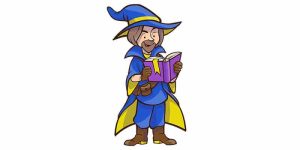Thieves in Dungeons and Dragons 5e are more like tomb-raiding treasure hunters than street urchin pickpockets—making Dexterity and Intelligence the primary ability scores to lean on. These characters are obsessed with magic items, delving into deep tombs or breaking into secure castles to acquire their prize.
Unique thief abilities will grant me the ability to disarm traps quickly, hide objects with Sleight of Hand, break into building more effectively, and eventually use any magic item I get my hands on. Mix these abilities with the stealth and ambush tricks of the rogue, and we have a dynamic character built for adventure.
When building a thief in DnD 5e, consider leaning on a treasure hunter theme with these elements in mind:
- Choose a race with Dexterity and Intelligence bonuses
- Build rogue character for thievery
- Understand rogue class abilities
- Use thief subclass abilities to collect and use magic treasure
- Blend higher level rogue abilities for a thief build
Choose a race with Dexterity and Intelligence bonuses
Dexterity is going to be the number-one ability score for the thief, as it governs finesse combat damage, light armor AC, Stealth, Sleight of Hand and trap escape. My next highest scores should be Intelligence, followed by Wisdom. Intelligence will allow me to solve puzzles, investigate rooms, and make History, Religion, Arcana and Nature checks to find treasure locations. Wisdom is mainly for Perception checks… because traps.
Therefore, we should consider races like forest gnome, tabaxi and high elf.
Forest gnomes gain a +2 to Intelligence and a +1 to Dexterity, hitting our two most needed ability scores. This character is little and quirky, giving off a greedy leprechaun vibe and gaining advantage on Intelligence, Wisdom and Charisma saves. Plus, forest gnomes gain the minor illusion cantrip and Speak with Small Beasts. Cunning and magical, this race of little people are perfect examples of this character build.
Tabaxi are catlike and natural stealth experts, gaining a +2 Dexterity and +1 Charisma bonuses. This character would literally be a cat burglar—probably with a black coat of fur. Feline Agility allows me to double my speed once per rest, and Cat’s Talent adds Stealth and Perception to my proficiencies. I’m already well on my way to what I need with just the race.
High elves gain a +2 Dexterity and +1 Intelligence bonus and offer a fun twist on the thief. Normally posh and royal, a down-in-the-gutter high elf thief is certainly different. However, they oddly fit the character perfectly as magic experts, and gain a wizard’s cantrip. As a bonus, they are proficient with a longbow, giving this rogue a better ranged weapon option.
Build rogue character for thievery
Because I choose the thief subclass at level 3, I’ll need to start my rogue on the right foot. Plus, I should understand all the abilities the basic class offers as I level up.
On the onset of my character build, I’ll choose a short sword, leather armor, short bow or hand crossbow, a burglar’s pack and thieves’ tools. I’ll also need proficiency in Stealth and thieves’ tools for most of my handy work. As I level into my role, I’ll need to play as a rogue in combat situations. However, my personality should 100% be that of a treasure-obsessed thief.
Play into this character’s obsession with treasure. Just like your real-life friends sitting around the table, treasure for him isn’t merely gold—he collects magic items. I’ll want to be sure I’m on the same page as my DM about how the campaign is built. Long term, this character will be a collector—giving me relevance as the rest of my party levels into super-wizards and monster slayers.
Related Posts:
Guide to Building Pirate Campaigns and Characters: DnD 5e
| Guide to Building a Rogue Assassin: DnD 5e
|
Understand rogue class abilities
Then, I’ll set off on my roguish adventure with three level-1 abilities: Expertise, Sneak Attack and Thieves’ Cant.
Expertise doubles my proficiency bonus for two ability checks or an ability check and thieves’ tools. Obviously, I’ll pick thieves’ tools as one option. The other should be Sneak, which will come in handy during combat and thieving.
Sneak Attack allows me to add an extra 1d6 damage to my damage roll if I hit an enemy with advantage. This could happen in several different scenarios, but it primarily comes from an ambush. As a rogue, I’ll try and hide when conflict appears to gain this bonus on an ambush attack. However, an ally could knock an enemy prone, opening another opportunity. This damage raises as I level up, quickly building to 2d6 at level 3 and 3d6 at level 5.
Thieves’ Cant is a secret language, a shorthand that only thieves can read. We can incorporate this type of ability with criminal underworlds inside of big cities. Maps, clues and signs could all include such odd language, especially when high-end magical treasure is involved.
Level 2 brings me Cunning Action, which is another staple rogue ability that grants me a bonus action to Dash, Disengage or Hide. As I enter my thief subclass, this bonus action will be extended. However, as a basic ability, this action allows me to escape one-on-one combat and attempt another surprise attack. I’ll need to be as slippery as possible in combat—I’m no tank.
Use thief subclass abilities to collect and use magic treasure
At level 3, I’m officially a thief and granted Fast Hands and Second-Story Work.
Fast Hands allows me to use my Cunning Action bonus to make a Sleight of Hand check, use my thieves’ tools or Use an Object. What? Let’s see these three scenarios in action.
- Sleight of Hand check: My ally starts a bar fight with a local guild, and I use a bonus action to steal an expensive bottle of liquor off the wall before I move or assist. I’ll later bribe a guard with the bottle to further my party’s goal.
- Use thieves’ tools to open lock or disarm trap: The party reaches the final room of the dungeon, where the evil necromancer keeps his most horrid creations. As my friends battle the corpse horrors, I slip through the chaos with a Dash action, unlock his cabinet of wicked wizard components as a bonus action, steal something to use against him and complete my movement away from danger.
- Use an Object: While searching through the necromancer’s cabinet, I find a gnarled wand. My Intelligence score allows me to use the magic item. So, on my next turn, I move into position with another Dash, and use a bonus action to use my wand to take control of one of his minions.
Second-Story Work is all about breaking and entering, with faster climbing ability and increased running jump distance. When I climb, it no longer costs me extra movement and my jump distance increases by my Dexterity modifier.
Higher-level thief abilities
As my thief levels, I’ll gain Supreme Sneak, Use Magic Device and Thief’s Reflexes to round out my stealthy treasure hunter.
Supreme Sneak gives me advantage on Stealth checks when I move less than half my speed. With a character built around Stealth from conception, this level-9 ability will secure an ultimate sneak.
Use Magic Device is a special trait for a treasure hunter like myself, allowing me to use any magical item even if it’s not intended for me. This means I have nothing blocking me from using any epic sword, wand, orb, staff, ring… whatever I find. This level-13 ability dips into the core features of the thief character.
Thief’s Reflexes gives me two turns on the first round of any combat encounter. The idea is that I will be able to set a trap or ambush and escape. I’ll take my first turn at my normal initiative. However, my second turn will be my initiative minus 10. Likely, the second turn will come at the end of combat, which will give a better idea of what to do for the next round.
Related Posts:
Guide to Building an Illusion Wizard: DnD 5e
| Guide to Building Puzzles: DnD 5e
|
Blend higher-level rogue abilities for a thief build
Higher level rogue abilities add to my ability to avoid damage, solve mysteries and work my way around the deepest dungeons. Though my basic class abilities will set the stage for most of my role throughout the adventure, these bonus abilities will come in handy. Let’s take a look at some higher-level abilities that are especially relevant to a thief.
- Uncanny Dodge allows me to use my reaction to half the damage I take from a melee attack. As far as staying alive is concerned, this is huge for me—Level 5.
- Evasion grants me the ability to take 0 damage on successful Dexterity saving throws for magical area effects—Level 7.
- Reliable Talent allows me to treat a d20 skill check of 9 or lower as a 10. Meaning, I can’t roll anything less than a 10 before adding my modifiers. This only works for skills I’m proficient in, including my thieves’ tools—Level 11.
- Blindsense gives me the ability to sense creatures within 10 feet of me when in total darkness. The idea is that I use my hearing and focus on a mental image—a useful trick for dark tombs. Level 14
- Slippery Mind gives me proficiency with Wisdom saving throws, allowing me to escape traps and spells more easily—Level 15.
- Elusive is the ultimate defensive tactic for the rogue class, negating any advantage on my enemies’ attack rolls. Level 18.
- Stroke of Luck is my ultimate rogue option, giving me an automatic hit when I roll a miss. This goes for combat or saving throws, and I must rest before I use it again. Level 20.
In conclusion
The thief concept in DnD 5e works well for me. I love the treasure-hunting aspect they added to the classic trope. Sure, we could always play a classic pickpocket or city dwelling scoundrel, but this is a game of adventure. The thief’s special abilities with magic items and disarming tools gives the character a definitive role in the group. Plus, the obsession with treasure gives the character a little more of a positive vibe.
What classic movie or television characters could we recreate as a thief in a DnD game? What kind of backstory would make the best tomb-raiding treasure hunter?
If you’d like to play this scoundrel in a custom pirate adventure, check out my original adventure, Dead Man’s Tale. Click here or below to learn more.






